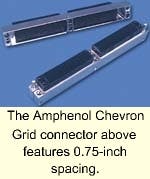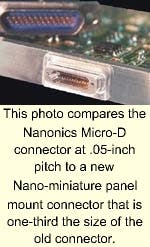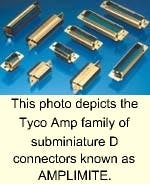Military and commercial requirements start to blend at the connector level
By J.R. Wilson
Military systems designers often struggle to adapt commercial off-the-shelf connectors to their projects, yet the days of purely military-grade connectors almost certainly are coming to an end
The military and aerospace systems designer needs high-density, high-speed electronic connectors, yet these requirements for speed and density increasingly place the designer at-odds with cost restrictions and with non-military commercial standards. This conflict makes the aerospace and defense program manager's job particularly difficult as he tries to fuse commercial-off-the-shelf (COTS) components with environmental and operational limits unique to his applications.
"Our customers are trying to use what's out there," explains Harry Cook, engineering manager for aerospace and defense at Teradyne Connections Systems in Nashua, N.H. "Cost is the driver, followed quickly by density and then speed, so they are trying to find low-cost solutions to high-performance needs.
Technological needs differ among separate projects, but core needs often remain the same when it comes to high-performance electronic connectors. Most of Teradyne's connector customers, for example, want "high real signals per inch," Cook says. "Some also want coax or optical fiber, but that usually is an add-on. Some say they want to use the VME bus structure, but want to couple it with high-density connectors they need, so we're doing kind of a mix. We're also talking to a lot of our customers about integrating optics into our commercial connectors."
Many technological requirements challenge the electronic connector industry as its practitioners as they seek to transfer financially lucrative COTS developments to the small-but-demanding aerospace and defense market. Among these challenges are designing for:
- nanominiature connectors, which are no larger than 0.025 of an inch pitch;
- hermetic seals;
- electrostatic discharge protection;
- controlled impedance contacts;
- extreme temperatures;
- expanded-beam fiber optic interconnection; and
- ruggedized VME with optical fiber.
"As digital electronics take over from analog, the size of the chips are considerably smaller and they require less electrical flow. That means smaller wires and smaller connectors," notes Bob Stanton, marketing vice president at connector supplier Nanonics Corp. in Phoenix. "So the demand is for smaller in size, significantly lower in weight, but in some requirements higher demands for ruggedness than ever before. We're using these for everything from remote control to surveillance aircraft, which have much higher levels of vibration, to standard range guided munitions.
Commercially developed connectors are coming under increasing pressure to perform reliably in environmental extremes, particularly with regard to temperature, Stanton says. One standard guide on microminiature D connectors is MIL-C-83513, which calls forth the full military temperature operating range of -55 to 125 degrees Celsius. The standard was written for Micro-D connectors that have a 0.050-inch pitch — twice that of the Nanonics Nano-connectors. No mil spec exists for the smaller nanominiatures, and manufacturers use MIL-C-83513 to test for ruggedness and reliability.
"A new additional demand for some connectors is the ability to operate above 125 degrees Celsius," Stanton says. "That's higher than MIL-C-83513. The reason is more and more military circuitry is getting exposed to geothermal orbit, which is a circuit in a military communications satellite that is rotating through the heat of the sun and the cold of space, which puts it through thousands of thermal cycles during its lifetime."
Creating connectors as small as 0.025-inch pitch that can meet the environmental guidelines of MIL-C-83513 requires a particularly rugged design, "usually a full metal housing, but on a tighter dimension," Stanton explains. "Then you usually have to have a pin and socket system that will handle the shock and vibration and a number of mates and de-mates; Nanonics has tooled a mated pair of seamless pins and solid gold-plated receptacle bores of beryllium-copper (BeCu) for their contact system," Stanton says.
"The insulating material, given you are at half the pitch you used to be, uses something like a liquid crystal polymer (LCP) insulator with glass in it," he says. "Fortunately, these digital circuits also run on a little lower voltage. That's good because the higher in the air you get, the more sensitive the insulator gets to breakdown. The LCP withstands that breakdown better. Another nice thing about LCP is it can be molded to exact positions, so it holds its true tolerances on the connector."
In addition to aerospace applications, Nanonics makes a 25-mil-pitch circular connector for Army helmets that need electromagnetic interference (EMI) shielding and water immersion seals. EMI shielding has become increasingly important in a variety of military and aerospace applications as demands for high-speed digital circuits that move data at millions of bits per second have increased, and with them the problem of electrical noise.
"In addition to making it smaller, you also have an EMI shielding problem, where the connectors have to be designed with a shield on the cable that can be sealed on the connector," Stanton says. "If the designer is already fighting weight and space, that means he's pushing the circuits closer together, which is what makes EMI shielding such a critical element. Most often, the shielding is braided, which looks like a Chinese finger puzzle made of stainless steel wires. It is dressed over the cable, then sealed in a 360-degree shield as it enters the back of the connector, so nothing is allowed to slip out and talk to the adjoining circuitry."
Trends in small connectors
The newest demand is for leading-edge technologies using 30-to-32-gauge micro-size coax cable going into nanoconnectors.
"There are two steps in looking forward to the next smaller connector," Stanton explains. "The European standard for 19.7 mils is one future step. The problem with going smaller than 25 mils is the PC board process hasn't caught up with the density. We're constantly trying to help the PC board people route the signals onto the boards. An alternate solution to that density problem on the board is to make surface-mount nanoconnectors that interface directly on the PC boards. That means you don't have wires going from the connector to the board anymore. Those are still on 25-mil pitch at the mil-spec end.
Several different design problems exist for military and aerospace connectors than those of popular commercial applications, he says. "There are a lot of things tighter than that on cellular telephones or wristwatches — say, 15mil pitch — but not in a mil-spec form," Stanton says. "The trick is to find a way to get our circuitry demanding lower voltage and currents in the military version to go to lower pitch and still meet some level of reliability. The military is still trying to push up to an amp; that would burn up those commercial devices using the lower mil pitch."
Engineers at Amphenol Aerospace of Sydney, N.Y. — a division of Amphenol Interconnect Products Corp., have developed high-density digital signal connectors containing differential pair contacts for controlled impedance for use in military avionics. Amphenol's customers historically have used the company's standard line replaceable module (LRM) connectors, says Amphenol marketing director Rick Aiken. The Amphenol LRM connectors required balancing signals and grounds, deriving different impedances by creating virtual coaxes, Aiken explains.
"With the differential pair, rather than having the customer do that, we've created a specific connector insert type that provides a controlled impedance line for a 100 ohm differential signal," he says. "That seems to be a popular standard for differential high-speed drivers, such as LVDS [low voltage differential signal].
Aiken says the real design challenge is to build these kinds of connectors that are able operate reliably under harsh military conditions. "These types of connectors are readily available in the commercial world, but usually are quite delicate — not made for military avionics applications," he says. "We are trying to bridge that gap. The customers have asked us to design this new differential signal insert to be incorporated with other inserts we already have tooled up that might be purely digital, a mixture of RF or power or even optical signals."
Amphenol also produces a ruggedized VME64X — three connectors on a standard board, packaged into one metal shell.
VME is a predominant COTS architecture that military systems designers use to combat rapid obsolescence. But the standard plastic connectors that come with VME boards and backplanes typically will not stand up to the environmental strains of a jet fighter. The VME64X resolves that by placing a military-capable connector on a COTS board.
Optical fiber connectors
"Another variance we're just releasing is a special fiber optic connector that goes into the P-zero center bay of that three-connector [VME] board," adds Rich Selfridge, Amphenol's engineering manager for advanced avionics products. "That is typically a 2-millimeter connector and is optional."
Amphenol has designed a connector to hold one MT ferrule (the cable part that surrounds the optical fiber), a product developed by Nippon Telegraph and Telephone (NTT) 20 years ago and widely used in telecommunications applications. It can hold as many as 12 optical fibers in one block.
"This gives our customers the opportunity to integrate optics into their VME systems through that central bay," Selfridge says. "That connector is not limited to just our VME connector, but can be integrated into older boards that had only the two outside connectors."
Another effort to address obsolescence is the integration of optical backplanes into military platforms. Optical backplanes are popular among some designers because technology development moves forward quickly, while avionics systems tend to evolve slowly — especially in the early development phase, Selfridge says. "By the time a typical military aviation system gets to production, they run into enormous component obsolescence problems. To mitigate that, they are looking to insert a completely optical interconnect in the avionics system, including an optical backplane."
An optical infrastructure in avionics would take advantage of quick and substantial development in the commercial world that could keep pace with advancement in processors and optical-to-electrical transducers, Selfridge says. "If you put that optical infrastructure into your aircraft early on ... you just need to remove the circuit boards and plug in new electronic circuit boards that will take advantage of that fiber and not have to replace the backplanes or box-to-box wiring."
Designers also can retrofit optical backplanes into existing architectures. The backplane is typically a line replaceable unit (LRU) in old aircraft; as designers upgrade that LRU, having a new optical backplane does not affect the rest of the system.
Industry experts expect to see very high density electrical interconnects in the near future, including those that can accommodate as many as 48 optical lines in four standard MT ferrules.
Teradyne is offering the high-density metric (HDM) six-row connector on a 2-millimeter grid and a VHDM (very high-density metric) 2-millimeter grid with an integral shield between each column, available with five, six and eight rows. Both were developed by the corporation's commercial division and offered as a COTS derivative for military and aerospace applications, which means they are not mil-spec but are built to the Bellcore specifications of the telecom industry.
"What we're seeing now is most of our customers are applying environmental testing at the box rather than the component level, says Andrew Spence, aerospace and defense applications engineer at Teradyne. "We have been working with several customers to qualify at the system level. The commercial connectors we've built are less than mil-spec for vibration, for example, but you can design boxes with dampening that will help alleviate the difference between what the connectors are tested to and what the boxes are seeing."
Spence explains that Teradyne experts have used military guidelines to qualify some of their connectors against severe Bellcore testing methods for outside commercial environments. Specifically, Spence says Teradyne experts used plating of 50 millionths of gold instead of 30 millionths of gold for these applications.
The military transition to COTS connectors also has forced Teradyne to increase its role dramatically as a backplane and packaging integrator as well as a producer of connectors. But Cook says the military also is going to have to change to adapt to evolving commercial specifications.
"There aren't many people out there who would want to be involved in the device business for a purely military customer base; that's waning," Spence points out. "These packagers will have to get innovative to use what is out there in such a way to meet the requirements of their systems and find ways to use commercial connectors in the same manner. They're already dealing with lifetime buys. Every four or five years there will be a technology insertion on these military programs and it will be part of the journey to do redesigns to keep up."
Failing to do so, he warns, is a sure road to serious obsolescence problems: "We're still making full metal wire-out panels to support our customer base. Can we continue to that forever? Absolutely not."
Earle Olson, aerospace account and industry manager for Tyco Electronics Corp. in Harrisburg, Pa., notes his firm also is pushing forward to meet increasing mil/aero demands for higher speed applications, noise suppression, and the adoption of FibreChannel protocols.
"We're getting into quadaxial contacts, putting high-speed copper into a Size 8 contact," Olson says. "That gives you the ability to control emitted noise by keeping the groupings of the quad cable construction symmetrical. We're also using 2-millimeter hard-metric controlled impedance to retrofit old hardware within military platforms, adapting that into new miniframeworks. That crosses the borders amongst technologies — from PCs to the COTS requirements of the military and aerospace industries, meeting those needs with standard equipment, but with some unique tweaks."
Another Tyco effort involves expanded beam fiber optic interconnection technology, which offers high reliability in extreme vibration and thermal environments. The fibers also are sealed behind a glass lens to protect them from dust, moisture, mud, and other contaminants. Enlargement of the light beam at the separable interface minimizes the effects of vibration, dirt, and debris.
Despite their benefits, expanded-beam connectors have not seen widespread use, however, because of higher cost and lower performance than butt-joint connectors have. But recent advances in precision machining, metrology and connector design have brought them more into line with conventional connectors in price and performance.
Expanded-beam connectors operate with an incoming light beam emerges from the fiber and crosses a small air gap to the first lens, Tyco experts say. The fiber at the focal point of the lens expands and collimates the beam into parallel rays as it emerges from the transmitting lens. The beam passes directly from the lens across a small fixed air gap at the separable interface. It then enters a second lens in an identical termination, which re-focuses the image toward the receiving fiber. The beam exits the receiving lens and crosses another small air gap to reach the receiving fiber. In this way, an image from the transmitting fiber falls on the end of the receiving fiber, positioned at the focal point of the second lens.
Hermetic connectors
Nanonics' Stanton says he believes the biggest change developing in military and space applications is what he terms the "hermetic evolution".
"What seems to be happening is instead of having a plug-in module, the government is thinking of a whole board as an element," he explains. "So part of the adjustment of the future is how do we come out of the back of a sealed plug-in element with our connectors," he says. "So we have developed a nanohermetic connector that goes through a hole in the sealed box containing the board and is then welded with a laser beam to the wall. That makes it a throwaway module."
In this approach, the nanoconnectors are not separate elements but are integrated into the modules. Inside, a flat customized circuit runs to whatever area is required and is capable, for example, of handling all the electronics needed to guide a Patriot missile.
"So when you can buy a single module that is hermetically sealed, it becomes just another part of a multifunction elemental design that plugs into a backplane in the platform," Stanton says. "That's one way of avoiding obsolescence — you can reprogram the unit to perform different functions. This is the nicest marriage I've seen of software and hardware."
Who's who in electronic connectors
Advanced Circuit Technology Inc.
Nashua, N.H.
603-880-6000
http://www.act-flexcircuit.com
Amphenol Aerospace
Sydney, N.Y.
607-754-4444
http://www.amphenol-aerospace.com/
AVX Myrtle
Beach, S.C.
843-946-0691
http://www.avxcorp.com/
BTC Electronic Components
Raleigh, N.C.
800-526-2828
http://www.btcelect.com/
Connector Technology Inc.
Somerset, N.J.
732-745-2880
http://www.connectech.com/
DDK
Santa Clara, Calif.
408-980-8344
http://www.ddkconnectors.com/
Erni
Chester, Va.
804-530-5012
http://www.erni.com/
FCI Interconnections Group
York, Pa.
717-767-7974
http://www.fciconnect.com/
G&H Technology
Camarillo, Calif.
805-484-
http://www.ghtech.com/
Harwin Electronics
New Albany, Ind.
812-285-0055
http://www.harwin.com/
ITT Cannon
Santa Ana, Calif.
714-557-4700
http://www.ittcannon.com/
JST Corp.
Waukegan, Ill.
800-947-1110
http://www.jst.com/
Methode Connector Products
Rolling Meadows, Ill.
847-392-3500
http://www.methode.com/
Molex Fiber Optics Inc.
Downers Grove, Ill.
800-213-4237
http://www.molex.com
Molex Inc.
Lisle, Ill.
800-786-6539
http://www.molex.com
Mountain Optech
Boulder, Colo.
303-444-2851
http://www.mt-optec.com
Nanonics Corp.
Phoenix, Ariz.
623-581-6188
http://www.nanonics.com
Omnetics Connector Corp.
Minneapolis, Minn.
800-343-0025
http://www.omnetics.com/
PCD Inc.
Peabody, Mass.
978-532-8800
http://www.pcdinc.com/
Positronic Industries
Springfield, Mo.
417-866-2322
http://www.positronic.com/
Teradyne Connections Systems
Nashua, N.H.
617-482-2700
http://www.teradyne.com/tcs
Tyco Electronics Corp.
Harrisburg, Pa.
717-564-0100
http://www.amp.com/


